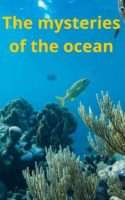The ocean, so vast and beautiful, yet also treacherous and mysterious. We barely see the tip of the iceberg when it comes to the ocean. Although the earth is about 70% water, around 95% is still unknown to us.
It is said that more is known about outer space than about the ocean. For instance, 12 men have stepped on the moon and only two have been to the deepest place in the ocean, the Mariana Trench. Scientists have been able to map the ocean floor, however, it may take many years to actually explore it.
There are many mysteries of the ocean, and many creatures that are quite bizarre looking. So it would be no surprise that there are a few very famous mysteries that are always spoken of.
Mysteries of the ocean:
The Bermuda Triangle
Ever heard of the Bermuda triangle? You know, the mysterious spot in the ocean where ships and planes disappeared?
The Bermuda triangle is found off the southeastern coast of the US in the Atlantic Ocean, between Bermuda, Florida and Puerto Rico. Bermuda is part of a busy shipping route and is probably part of the reason why many ships have disappeared.
The points at which the ships and planes disappeared all took place inside the points of a geographic triangle, hence the name Bermuda Triangle. Discover Magazine provides a possible explanation as to why ships are more prone to sink in the Bermuda Triangle: “Any region with lots of ships going through it is bound to see more accidents than a place with less activity. Pair that with the fact that the Bermuda Triangle is often swept by hurricanes, and it’s not hard to see why ships might occasionally sink there.”
The Mariana Trench
According to Deepseachallenge.com, “Located in the western Pacific east of the Philippines and an average of approximately 124 miles (200 kilometers) east of the Mariana Islands, the Mariana Trench is a crescent-shaped scar in the Earth’s crust that measures more than 1,500 miles (2,550 kilometers) long and 43 miles (69 kilometers) wide on average.” In 1960, Jacques Piccard and Navy Lt. Don Walsh, both from the United States of America, were the first to descend to the depths of the Mariana Trench. The aim of their expedition was to find out if life could exist under such extreme pressure and to take photographs. They couldn’t get any photos because it was too murky but the lights of their submersible illuminated a creature that looked like a flatfish. Thus a very important scientific question was answered, but scientists want to find out much more.
Milky Sea Phenomenon
According to BBC earth, “Also called mareel, the milky sea is caused by bioluminescent bacteria, billions or trillions of them, that live throughout the water column from the surface to the sea floor.”
Sailors who have seen the strange phenomenon have explained it feels as if they are floating through snow. Can you imagine how scary that must be to suddenly see white foam all around you and you did not have an explanation for it?
Creatures of the deep
Since there are so many more things left to explore in the deep blue sea, it would be no surprise that there are still sea creatures unknown to us. There are probably many creatures that we do not know about, even with our modern technology, but according to Animal Wised, one rare creature we do know about is the frilled shark, a very odd-looking creature: “The frilled shark is totally different from the carpet shark, but remains just as unique and strange. This extremely ancient specimen inhabits the depths of the Atlantic and Pacific Ocean. Although it falls under the shark family, they eat prey like a snake does: they bend their body and lunge forward, proceeding to swallow their victim whole.” Sounds like something from a movie; two fears in one!
Other rare creatures include the spiny king crab, the monkey brittle star, the smooth-head blobfish, the deep-sea lizard fish and giant oarfish.
Fun facts about the ocean:
- The ocean contains around 1.35 billion cubic kilometres of water
- The ocean has five major life zones. According to Oceana.org website the five zones are the epipelagic zone (upper open ocean), the mesopelagic zone (middle open ocean), bathypelagic zone (lower open ocean), and the abyssopelagic zone (this zone stretches from the bottom of the bathypelagic to the seafloor). The fifth zone is the hadalpelagic zone: “Where deep, wide trenches occur in the otherwise flat seafloor, the open water that fills them is the hadopelagic zone.”
- Fishers catch more than 90 million tons of seafood each year
- 70% of the oxygen on earth comes from the ocean
- It is estimated that there are three million shipwrecks on the ocean floor
“Life is like the ocean. It can be calm or still, and rough or rigid, but in the end, it is always beautiful.” – Anonymous
***
Tell us: What was your favourite fact in The Mysteries of the Ocean?
Read more here on why sharks are important for the environment.

